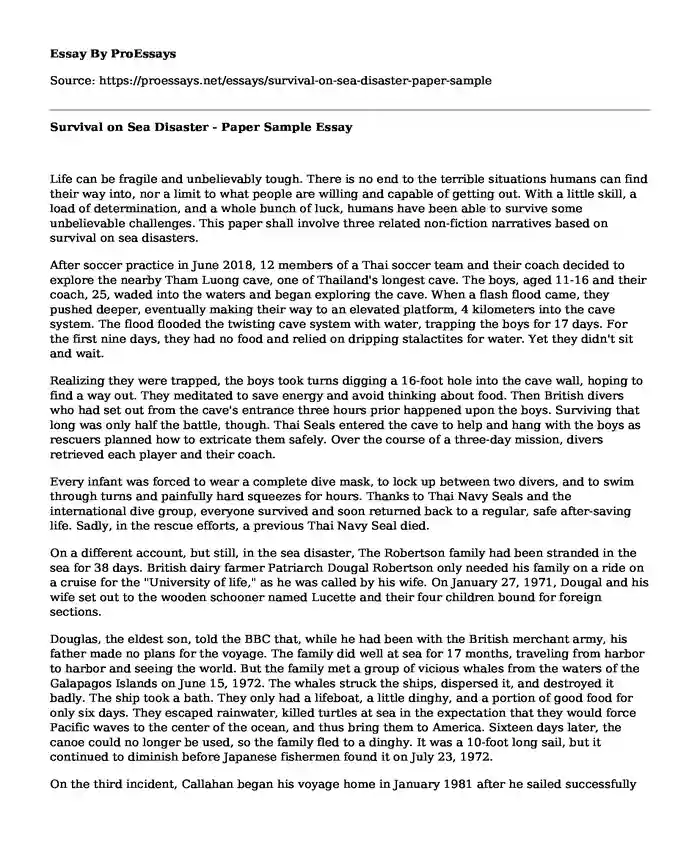Life can be fragile and unbelievably tough. There is no end to the terrible situations humans can find their way into, nor a limit to what people are willing and capable of getting out. With a little skill, a load of determination, and a whole bunch of luck, humans have been able to survive some unbelievable challenges. This paper shall involve three related non-fiction narratives based on survival on sea disasters.
After soccer practice in June 2018, 12 members of a Thai soccer team and their coach decided to explore the nearby Tham Luong cave, one of Thailand's longest cave. The boys, aged 11-16 and their coach, 25, waded into the waters and began exploring the cave. When a flash flood came, they pushed deeper, eventually making their way to an elevated platform, 4 kilometers into the cave system. The flood flooded the twisting cave system with water, trapping the boys for 17 days. For the first nine days, they had no food and relied on dripping stalactites for water. Yet they didn't sit and wait.
Realizing they were trapped, the boys took turns digging a 16-foot hole into the cave wall, hoping to find a way out. They meditated to save energy and avoid thinking about food. Then British divers who had set out from the cave's entrance three hours prior happened upon the boys. Surviving that long was only half the battle, though. Thai Seals entered the cave to help and hang with the boys as rescuers planned how to extricate them safely. Over the course of a three-day mission, divers retrieved each player and their coach.
Every infant was forced to wear a complete dive mask, to lock up between two divers, and to swim through turns and painfully hard squeezes for hours. Thanks to Thai Navy Seals and the international dive group, everyone survived and soon returned back to a regular, safe after-saving life. Sadly, in the rescue efforts, a previous Thai Navy Seal died.
On a different account, but still, in the sea disaster, The Robertson family had been stranded in the sea for 38 days. British dairy farmer Patriarch Dougal Robertson only needed his family on a ride on a cruise for the "University of life," as he was called by his wife. On January 27, 1971, Dougal and his wife set out to the wooden schooner named Lucette and their four children bound for foreign sections.
Douglas, the eldest son, told the BBC that, while he had been with the British merchant army, his father made no plans for the voyage. The family did well at sea for 17 months, traveling from harbor to harbor and seeing the world. But the family met a group of vicious whales from the waters of the Galapagos Islands on June 15, 1972. The whales struck the ships, dispersed it, and destroyed it badly. The ship took a bath. They only had a lifeboat, a little dinghy, and a portion of good food for only six days. They escaped rainwater, killed turtles at sea in the expectation that they would force Pacific waves to the center of the ocean, and thus bring them to America. Sixteen days later, the canoe could no longer be used, so the family fled to a dinghy. It was a 10-foot long sail, but it continued to diminish before Japanese fishermen found it on July 23, 1972.
On the third incident, Callahan began his voyage home in January 1981 after he sailed successfully on his 6.5 meters sloop through the Atlantic solo. One night the storm surrounded his boat, but a whole shark or whale put in his hull in the middle of the night in the middle of the storm.
When the boat started falling, Callahan fell into the sinking ship again and again to take the survival equipment. Callahan sat in a 6-foot circular canoe, traveling 800 miles west of the Canary Islands with food and water for a few days and was going at all times south. With a spear pistol, Callahan was fishing, making water still with a solar. On the 14th, he reported to a passing boat but continued to cross.
He drove away from the shipping lanes after a month. On day 50, he was covered in saltwater sores, was confronted with tropical dehydration, and struggled to patch a hole in his raft. Callah was finally spotted by some fisher people off the coast of Guadeloupe when birds and fish circled his raft and forged the fish he threw back into the sea after losing a third of his body weight. He was 76 days adrift.
Works Cited
Golden, Frank, and Michael Tipton. Essentials of sea survival. Human Kinetics, 2002.
Tougias, Michael J. Fatal Forecast: An Incredible True Tale of Disaster and Survival at Sea. Simon and Schuster, 2007.
Zerrudo, Ma Rosalie. "Theater of Disaster, Folk Stories as Vehicles for Healing and Survival." Teaching Artist Journal 14.3 (2016): 161-170.
Cite this page
Survival on Sea Disaster - Paper Sample. (2023, Dec 13). Retrieved from https://proessays.net/essays/survival-on-sea-disaster-paper-sample
If you are the original author of this essay and no longer wish to have it published on the ProEssays website, please click below to request its removal:
- Essay Sample on Cultural Relativism
- Essay Example on Popular Culture in the Age of Social Media
- Savannah Wind Symphony's Concert Critique
- Essay Sample on Traditional to Modern: The Transition of Chinese and Pakistani Weddings
- Essay Sample on Preserving Cultural Identity: The Vital Role of Cultural Maintenance
- Essay Example on Cultural Awareness: A Necessity for Caregivers in Society
- Free Essay Sample on Biospheric Altruism







